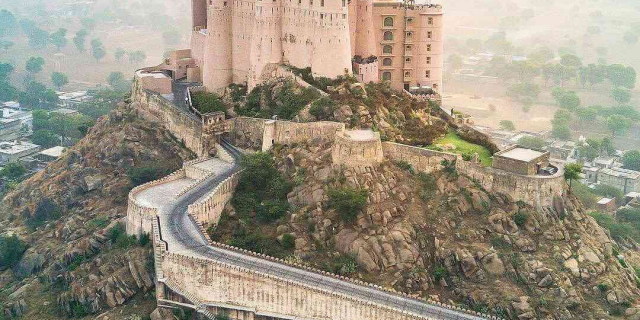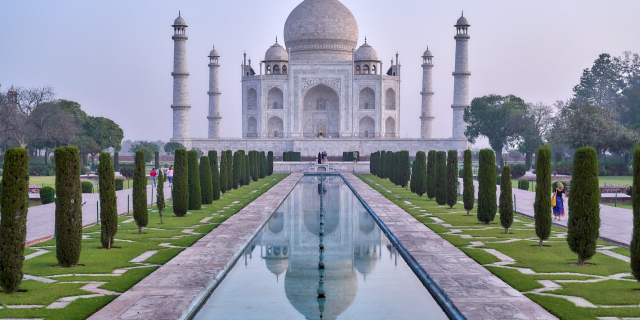Ranthambore Fort lies within the Ranthambore National Park, near the city of Sawai Madhopur in Sawai Madhopur district of Rajasthan, India. the park being the former hunting grounds of the Maharajahs of Jaipur until the time of India's Independence. It is a formidable fort having been a focal point of the historical developments of Rajasthan. The fort is believed to be constructed by numerous kings from Several Dynasties including Yadav lineage (though it has been a topic of debate that it was Ahir kings or the Rajput yaduvanshi kings But looking at the Timeline it was constructed in the 5th century and the word Rajput itself was originated in the 12th century it has been speculated by the Archaeological department of the Jaipur circle that it was the Yadavs(Ahirs) who started its construction),Chahamana Rajputs, Hada Rajputs, Mewar Rajput Kings and then the Delhi Sultanate captured it for a brief time. The fort provides a panoramic...Read more
Ranthambore Fort lies within the Ranthambore National Park, near the city of Sawai Madhopur in Sawai Madhopur district of Rajasthan, India. the park being the former hunting grounds of the Maharajahs of Jaipur until the time of India's Independence. It is a formidable fort having been a focal point of the historical developments of Rajasthan. The fort is believed to be constructed by numerous kings from Several Dynasties including Yadav lineage (though it has been a topic of debate that it was Ahir kings or the Rajput yaduvanshi kings But looking at the Timeline it was constructed in the 5th century and the word Rajput itself was originated in the 12th century it has been speculated by the Archaeological department of the Jaipur circle that it was the Yadavs(Ahirs) who started its construction),Chahamana Rajputs, Hada Rajputs, Mewar Rajput Kings and then the Delhi Sultanate captured it for a brief time. The fort provides a panoramic view of the surrounding Ranthambore National Park and is now a popular tourist attraction.
In 2013, at the 37th session of the World Heritage Committee, Ranthambore Fort, along with 5 other forts of Rajasthan, was declared a UNESCO World Heritage Site under the group Hill Forts of Rajasthan.
Archeological department of Jaipur circle the Ranthambore Fort was initially built by King Jayant in 5th century CE. Descendent of Jayant ruled over it till they were expelled by Prithviraj Chauhan in the 12th century. Subsequently, the fort was later occupied by the Muslim rulers of Delhi. Hammiradeva was the most powerful ruler of Ranthambhore
Under Chauhans RajputsIts earlier name was Ranastambhapura (Sanskrit: Raṇa-sthaṃba-pura, "City of the Battle Post").[1] It was associated with Jainism during the reign of Prithviraja I of Chahamana (Chauhan) dynasty in the 12th century. Siddhasenasuri, who lived in the 12th century has included this place in the list of holy Jain tirthas. In the Mughal period, a temple of Mallinatha was built in the fort.[2]
After the defeat of Prithviraja III (Prithviraj Chauhan) in 1192 CE, the fort came under the control of the Muslim Ghurid ruler Muhammad of Ghor.[3]
The Delhi Sultan Iltutmish captured Ranthambore in 1226, but the Chauhans re-captured it after his death in 1236. The armies of Sultan Nasiruddin Mahmud, led by the future Sultan Balban, unsuccessfully besieged the fortress in 1248 and 1253, but captured from Jaitrasingh Chauhan in 1259. Shakti Dev succeeded Jaitrasingh in 1283, and recaptured Ranthambore and enlarged the kingdom. Sultan Jalal ud din Firuz Khalji briefly besieged the fort in 1290-91 but was unsuccessful in capturing it. In 1299, Hammiradeva sheltered Muhammad Shah, a rebel general of Sultan Ala ud din Khalji, and refused to turn him over to the Sultan. The Sultan besieged and conquered the fort in 1301.
Under MewarThe fortress was captured by various kings of Mewar. Ranthambore was under the direct rule of Rana Hamir Singh (1326–1364), Rana Kumbha (1433–1468) and Rana Sanga (1508–1528).[4][5][6]
Under Hadas Akbar's entry into the fort of Ranthambore, 1569, Akbarnama
Akbar's entry into the fort of Ranthambore, 1569, AkbarnamaDuring Rana Udai Singh I's reign (1468–1473) the fortress passed to the Hada Rajputs of Bundi. Sultan Bahadur Shah of Gujarat briefly captured the fortress from 1532 to 1535. The Mughal Emperor Akbar captured the fortress in Siege of Ranthambore (1568) from Hadas.[citation needed]
 Official government Inscription Slab at the Ranthambore Fort gate, states the earliest known Builders of the forts, The YadavsUnder Jaipur
Official government Inscription Slab at the Ranthambore Fort gate, states the earliest known Builders of the forts, The YadavsUnder Jaipur
The fortress passed to the Kachwaha Maharajas of Jaipur in the 17th century, and it remained part of Jaipur state until Indian Independence. The area surrounding the fortress became a hunting ground for the Maharajas of Jaipur. Jaipur state acceded to India in 1949, becoming part of the state of Rajasthan in 1950.
TemplesInside Ranthambore fort, there are three Hindu temples dedicated to Ganesha, Shiva and Ramlalaji constructed in 12th and 13th centuries from red Karauli stone. There is also a Jain temple of Lord Sumatinath (5th Jain Tirthankar) and Lord Sambhavanath.






























Add new comment